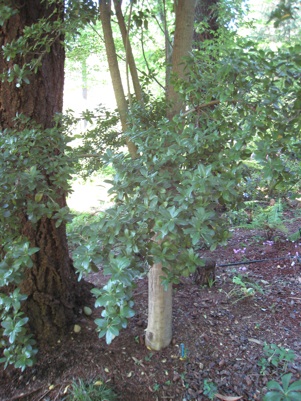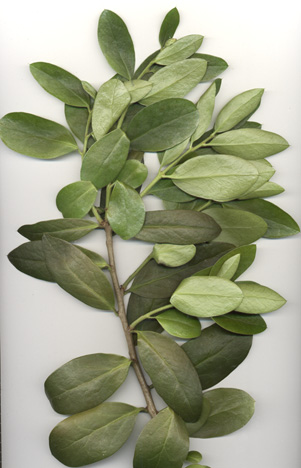Plant of the Month: May 2007
|
| Trevo tree |
Dasyphyllum diacanthoides (Less.) Cabrera
|
COMPOSITÆ (ASTERACEÆ); Sunflower Family
|
| The Sunflower family of plants is regarded as mostly herbaceous to us northern hemisphere gardeners. Well, guess what? It is a gigantic and widespread family; many members are woody, and some are even trees. The Trevo tree from central Chile and Argentina is --as far as I have learned-- about as large as any other member in the whole family of 22,750 to 25,000 species, having been recorded to 20 meters tall (65.5 feet) with trunks 1.5 meters thick (5 feet) (An International Dendrology Society tour in Chile on March 7th, 2007, found one 13 meters in circumference =42.5 feet, or 13.5 feet in diameter!). I realize that ordinary Western American sagebrush (Artemisia tridentata) and certain other sunflower family plants may rarely have thicker trunks, but they do not grow as tall. The Trevo tree is a forest tree. It is also called Palo santo (Sacred wood) and Palo blanco (White wood), Tayú, Tagu or Tallu. |
| Dating from 1820, the generic name Dasyphyllum is from the Greek dasy-, thickly hairy, and phyllon, a leaf --presumably alluding to the very hairy leaves of the species first described: Dasyphyllum argenteum HBK. There are 35 to 41 species of Dasyphyllum, all broadleaf-evergreen trees or shrubs, nearly all relatively cold-tender, and all South American: from E Brazil, Venezuela, the Andes from Colombia to NW Argentina, and in central Chile. Gerbera is the only genus cultivated in the north that is related closely to Dasyphyllum. In 1959 the accomplished scientist Angel Lulio Cabrera (1908 - 1999) published the definitive monograph of Dasyphyllum: Revisión del género Dasyphyllum (Compositae) --a 79 page treatment that I have not read. |
Dasyphyllum is of almost no economic importance. Its wood is not valuable. A 2008 book. Plants Patagonica, says "Its bark is used in popular medicine as a drink to clean up the blood, soothe the nerves and act against lung disease." Certainly the species I feature this month has a potential role as an ornamental large shrub or small tree. I was utterly unaware of it until this month when I visited the former Heronswood Nursery of Kingston, Washington, and saw there a splendid specimen. It was a tree 24.5 feet tall, with a single trunk. Looking at it, I could tell that it was in the Sunflower Family, and guessed that it was from the southern hemisphere, but had no idea what it was. The leaves were spotless dark green, glossy, densely arranged on softly drooping twisty branches that pleased my eyes. The pale soft bark contrasted handsomely. So, I got inspired to learn all about it, and now am sharing my findings with you. Because it is so little known, and yet curious as a tree related to daisies, and is good-looking, I desire to promote awareness of it. As far as I know it is not yet known in European cultivation, and is exceedingly scarce in North America.
|
| It has been cultivated in the northern hemisphere since at least 1961. In September of that year seeds were sent to Washington Park Arboretum in Seattle, from the Botanic Garden of Buenos Aires, Argentina. There are still specimens alive in the Seattle arboretum, though periodically they have been cut back by severe winter cold. At present the tallest there is a multiple-trunked large shrub only 18.5 feet tall. It stands 75 feet uphill from the lookout gazebo, and is labeled with the accession number 428-61 A. There is a smaller example in the Rock Garden area, but it is apt to be transplanted due to a major construction project. |
| The tree's native range includes elevational differences of from 500 to 1,500 meters --if not more. Some of its forest tree associates include Drimys Winteri and Nothofagus Dombeyi --two other broadleaf evergreen trees cultivated in Seattle. |
| The leaves are always thick and glossy; they vary much in size. The largest attain 3 inches long (7.5 cm), but many are less than .5 inches long (1.3 cm). The widest are 1.5 inches across (3.8 cm). The uppersides of the leaves are darker green, the undersides paler; both sides are glossy and nearly hairless except for the short petiole. The leaves are tipped by tiny sharp prickles. Many of the twigs bear paired slender thorns, explaining the 1832 specific name diacanthoides. |
| In the wild the tree flowers from November into February. Thus, it is summer blooming. In Seattle it blooms in July - August (When I went to look at the Arboretum specimen on the 4th of July 2007, it appeared to be done blooming!). The flowers are numerous, small, white, and aromatic, but not very showy. |
| Over the years the Trevo tree has been sold by Heronswood Nursery (www.heronswood.com). It was first listed in the 1995 catalog. Dan Hinkley wrote then of it: |
| "We are indebted to Susyn Andrews of Kew for identifying this shrub for us. Extremely rare in cultivation, this evergreen rises to 5 feet with false whorls of dark glossy leaves and small spines along the stems." In 1997 Dan added: "Produced its terminal white daisies for the first time for us this summer." In 1999 the catalog states: "I felt fortunate indeed to witness this remarkable evergreen shrub or tree in its native haunts of Chile in the spring of 1998, and have come away with renewed admiration for it." It was last mentioned in the 2004 catalog, where Dan added that the flowers are followed by "pretty silky tufts of white achenes." |
| Dan lists it as preferring "sun and well-drained soil." Both specimens at Washington Park Arboretum are certainly enduring such conditions. But the 24.5 foot tree (27 feet tall in 2009) at Heronswood is in a woodland garden, with irrigation. Moreover, the library sleuthing that I did suggests that Trevo trees enjoy humidity, so I am sure that they by no means require either sun or especially well-drained soil. But it should be planted in an area that is more or less protected from severe winter cold. |
| The tree has also been offered by Colvos Creek Nursery of Vashon Island, near Seattle (www.ColvosCreekNursery.com). Owner Mike Lee wrote of it in the 2004, 2005 & 2006 catalogs: "Luxuriant, seldom grown Chilean shrub of the forests of S Chile. Thick, glossy, oval 1-2 inch leaves in deep green clothe its thick, stout, spiny branches. Attractive and sturdy barrier reaching 8 feet or more." Mike Lee has grown it only from cuttings. At present, neither Heronswood nor Colvos Creek has it in stock. So you must wait patiently, or buy seeds from a seed dealer, or grow your own from cuttings. If anyone who has a specimen planted desires to share details about its growth, appearance and hardiness, I welcome such information. |
The photo below is the bottom of the Heronswood tree; and a scan below shows the leaves and a flower bud barely visible near the top. In the summer I will scan a twig full of flowers and add that image for you to see . . .
Back |

Heronswood Dasyphyllum photo by ALJ |

Dasyphyllum scan by ALJ |
|
|

